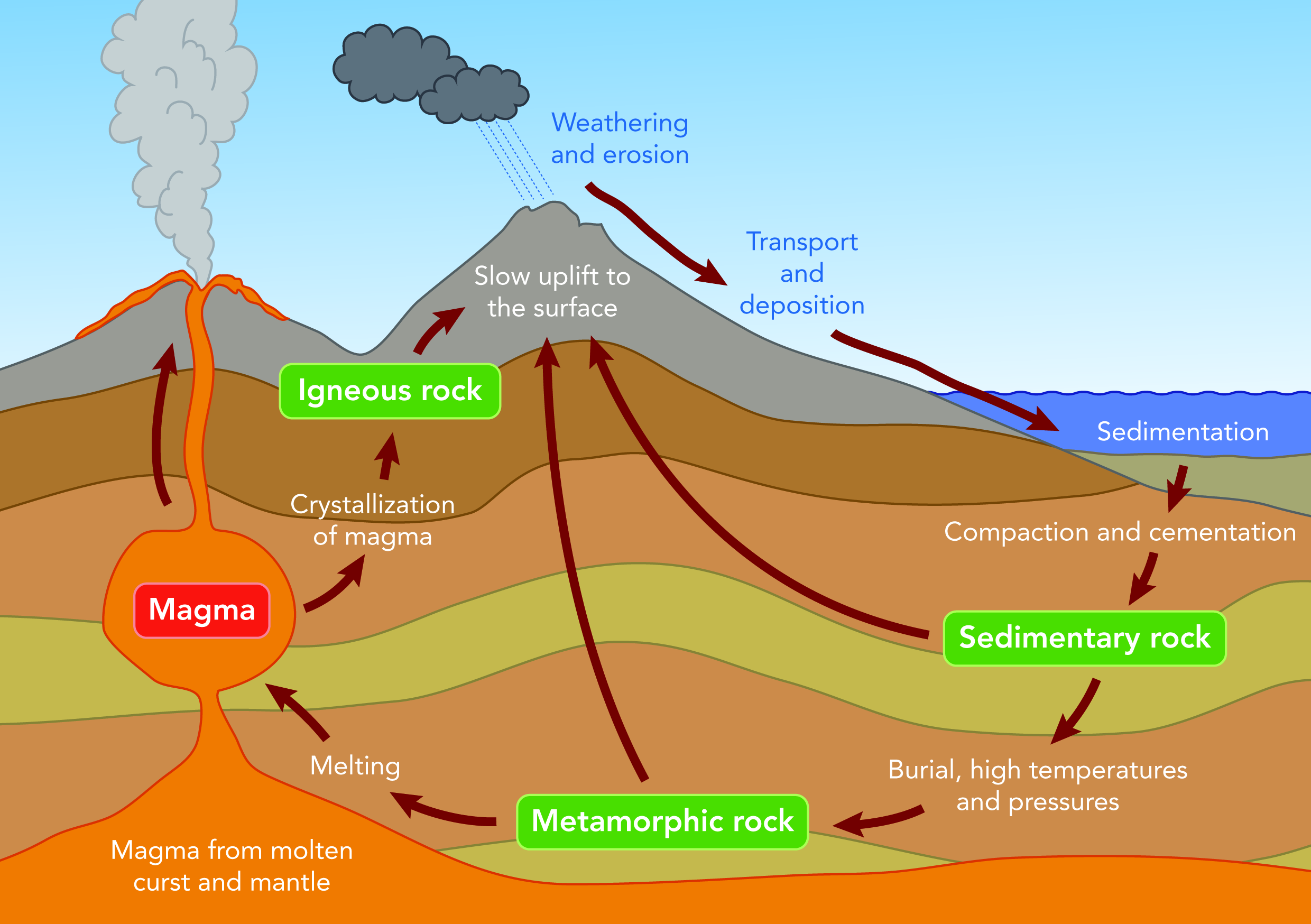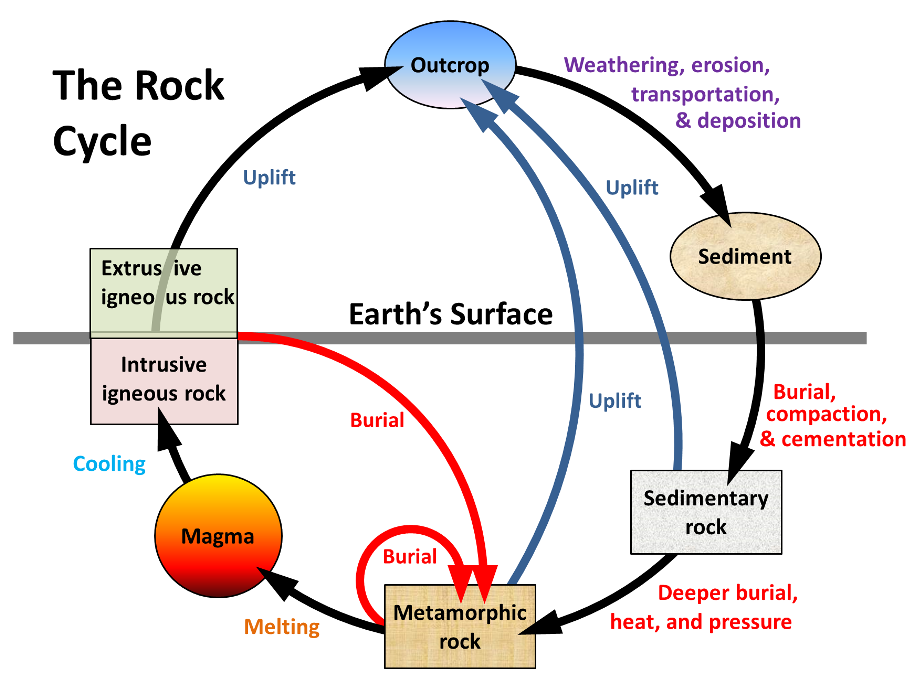A solid material made of minerals that forms the Earths crust. Arrows connecting the three rock.
The rock cycle describes geologic processes in which.

. Igneous rock The rock cycle describes the process by which changes occur in the three types of rocks. The geologic cycle is a collective term used to describe the complex interactions between the component sub-cycles of tectonic hydrologic rock and the biological cycling of elements known as the biogeochemical cycle. Clastic organic biological and chemical.
Can increase because new and inexpensive methods of processing lower grade ore can be developed and can become profitable if the price of the metal in a. The rock cycle is a basic concept in geology that describes transitions through geologic time among the three main rock types. Rocks never remain same and they are always changing with time.
Sediment Clastic sedimentary rock 4. Igneous rocks are primary rocks and other rocks sedimentary and metamorphic form from these primary rocks. In the rock cycle illustrated in figure 8 the three main rock typesigneous sedimentary and metamorphicare shown.
Rock cycle processesJPG Q Search コ 6. Note that any rock type can be weathered to become sediment and then a sedimentary rock. You may use some processes more than once.
Changes The rock cycle describes how the three major types of rock--metamorphic igneous and sedimentary--can change into one another through. Each of these rocks are formed by physical changessuch as melting cooling eroding compacting or deformingthat are part of the rock cycle. The rock cycle is a general model that describes how various geological processes create modify and influence rocks Figure 10a-1This model suggests that the origin of all rocks can be ultimately traced back to the solidification of molten magma.
The geologic cycle is a term used to describe the complex interactions between the different sub cycles of other process such as tectonic hydrological rock and biogeochemical cycle. The Rock Cycle Drawing by Phyllis Newbill Through geologic processes each type of rock can be re-formed into any of the three types. Types of Rocks and types of rock formations.
Rocks do not remain in their original form for long but may undergo transformation. The processes involved in the rock cycle often take place over millions of years. The three major categories are.
Gas or ash emissions changes in the shape of the volcano temperature anomalies The study of resources that are valuable for manufacturing and trade. So on the scale of a human lifetime rocks appear to be rock solid and unchanging but in the longer term change is always taking place. Extrusive igneous rock Intrusive igneous rock 2.
Rock cycle is a continuous process through which old rocks are transformed into new ones. The rock cycle illustrates and describes how geologic processes occurring both at the surface and underneath the Earths surface can continuously transform or change a rock from one type to another Figure 233 The melting of rocks occu rs within the Earths crust and the upper mantle because of extreme heat. The rock cycle basic definiton is transitions among the three main rock types which are metamorphic igneous and sedimentary rocks.
Sedimentary Rocks Sedimentary rocks are formed from pieces of other existing rock or organic material. Practice Rock Cycle Processes. Rocks are classified according to their place in the geologic cycle.
All types of rocks change from one type to another over time Intrusive igneous rocks form when magma solidifies. Any rock type can also be. Sedimentary metamorphic and igneous.
Igneous rocks can be changed into metamorphic rocks. Given the rock cycle diagram below match the appropriate geologic process with the corresponding numbered box. Chemical sedimentary rock 5.
It was developed by 18th-century Scottish farmer and naturalist James Hutton according to Visionlearning. The best way to predict an impending volcanic eruption is to look for all of the following except. There are three main rock types.
Presents the three major rock types and the processes that lead to their formation in the rock cycle. Rocks are constantly being recycled and go through several processes of chemical and physical changes. The rock cycle simply moves from the igneous to metamorphic to sedimentary rocks and the process repeats itself over and over.
The rock cycle describes the processes and transitions through geologic time of the three rock types. Rock cycle is a basic concept in geology that describes the time-consuming transitions through geologic time. The geologic cycle begins with magma a molten rock deep inside the earth.
These various subcycles influence each other and may produce natural hazards and processes important to environmental geology. Sedimentary igneous and metamorphic Rocks at the Earths surface are subject to and transforming into sediment that is then deposited and undergoes and turning into a sedimentary rock through a process call Rocks in the subsurface. For example an igneous rock such as basalt may break down and dissolve when exposed to the atmosphere or melt as it is.
This magma cools as it moves upward toward the ground surface forming igneous rocks. There are three different types of sedimentary rocks. The rock cycle is a continuous process describing the transformation of the rocks through various stages throughout their lifetime.
Rock that forms when molten rock cools and hardens. The Process of Rock Cycle. Each of the rocks can be altered when they are force out equilibrium conditionsThe rock cycle describes how the three rock types are interrelated and how processes change from one to another over time.
A naturally occurring inorganic solid that has a crystal structure and a definite chemical composition. Weathering and erosion near the Earths surface create the materials for ____ rocks. Metamorphic rocks form when pre-existing rocks are subjected to heat and pressure.
This indicates how strong in your memory this concept is. Transcribed image text. Each rock type is altered when it is forced out of its equilibrium conditions.
These various sub cycles sometimes interact to cause natural disasters such as landslides earthquakes and volcanic activity Slideshare Online. Terms in this set 20 rock.

3 5 The Rock Cycle Physical Geography And Natural Disasters



0 Comments